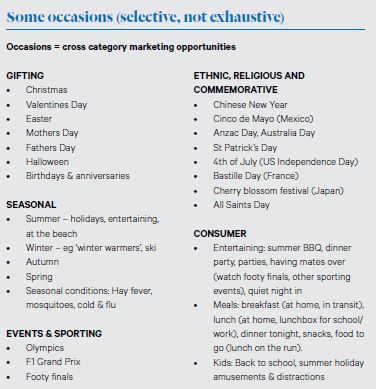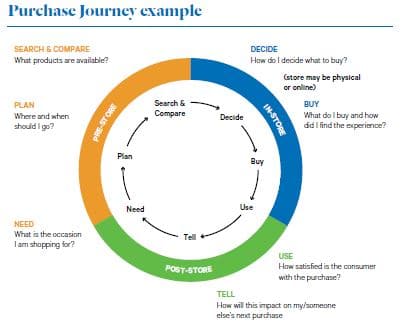What is shopper marketing and why do it? The Retailer looks at the applications of shopper marketing for retailers.
By Norrelle Goldring* – GfK
Since its origins with Procter & Gamble and Walmart in the US in 2001, shopper marketing has increasingly been adopted by brand manufacturers and to some extent by retailers. But outside the FMCG arena, what are its applications for retailers?
Given its origins in FMCG, the definitions of shopper marketing refer to both brand manufacturers and retailers. There are a number of them, but for
simplicity, one of the most commonly used definitions is: “Shopper marketing is the use of insights-driven marketing and merchandising initiatives to satisfy the needs of targeted shoppers, enhance the shopping experience and improve business results and brand equity for retailers and manufacturers.”
I would add here that shopper marketing applies to each stage of the customer’s purchase journey, starting with ‘need’ identification and finishing these days not with ‘buy’, but with ‘use and tell’ (leading to repeat purchase). The increasing use of social media means that in some cases there is now
an additional stage before ‘need’, which is ‘inspiration’.
For example, an item – a new sofa, say – may not be an identified need by a particular shopper, but if someone in their network posts a picture of their
new loungeroom fitout on Pinterest or Facebook it may trigger a desire to investigate.
Shopper marketing involves multiple communications touchpoints along a customer’s purchase journey. Touchpoint types range from traditional ‘above the line’ (TV, radio, print) to word of mouth/social (face to face, text, email advocacy, Facebook, Twitter, etc), digital and online, to instore (off-location displays, staff, signage, shelf fins, etc).
These touchpoints, and what a shopper needs from them and thus how they should be messaged, can change by purchase journey stage. When shopping for a TV, for instance, shoppers may research manufacturer websites to look for product specifications and features; retailer websites for who has which brand at what price; and instore to get an idea of how big the TV is, picture quality compared to other TVs, and talk to staff about deals.
What is not shopper marketing?
- Shopper marketing (SM) is not category management. Category management was originally based out of supply chain management and is a hygiene factor predominantly around range and space, which enables shoppers to find the right things easily in order to improve conversion rates. It’s a fundamental building block of good retailing, yes, but it is not marketing per se
- SM is not only what you do instore. An off-location display by itself does not constitute shopper marketing. SM involves using multiple touchpoints – pre-store, instore, post store, and digital/social – along a customer’s purchase journey
- SM is not only about price. In fact, it’s almost the opposite – providing shoppers with reasons to buy a category from you based on relevance to their
needs, and appeal (while potentially still being good value). Shouting about being the cheapest is not shopper marketing - SM is not just a brand message at the shelf. Brand benefits such as ‘cleans whiter’ or ‘great tasting’ or even ‘new’ are not shopper marketing.
How is SM different?
Everyday retail execution and merchandising, including off-location displays, and even running sales, are not shopper marketing, however, executing cross category against specific occasions using multiple communications points, such as back to school, is getting closer to it.
Historically, shopper marketing has been short term campaigns based around a specific insight, need, or opportunity (although the insights and research used to understand opportunities for shopper marketing campaigns can also be used to drive longer term marketing strategy).

Occasions talk to relevance, and the categories and brands you range in an occasion-based campaign need to be specific to that occasion. Aeroguard and Band-Aids would work for the ‘Easter camping trip’ occasion, but not really for ‘kids lunchbox’ (although Band-Aids could work for back to school).
The best shopper marketing campaigns are often based around a platform, which provides multiple occasions and categories within one central idea that can be rolled out across the year.
A couple of US examples are Walmart’s health and wellbeing platform, which incorporates categories ranging from sports bars to exercise equipment to vitamins, and manufacturer Conagra’s Six Seasons of Mom, which is based on the key occasions throughout the year when ‘mom’ needs to cook for the family. (A somewhat traditional idea perhaps, but nevertheless.)
Shopper marketing campaigns can also overcome barriers to consideration of a product or category.
Purina’s ‘Lift it to believe it’ in cat litter is an example of this. In cat litter, one of the shopping barriers is the weight of the product – getting it off the shelf into the cart, from the cart to the car, and from the car into the house. In the ‘Lift it to believe it’ campaign, shoppers were encouraged
to road test the product by lifting the new Purina product and other products to compare the weights. The campaign was supported with out of store communications.
The benefits
In the short term, good shopper marketing campaigns drive traffic and sales by providing a reason for shoppers to visit your store (rather than someone else’s) beyond price, in a way that talks to their needs. In the longer term, the continued activation of various shopper marketing campaigns helps create the impression of your store being a destination, because you evidently understand shopper’s needs.
Opportunities
Retailers have the opportunity to build a bank of insights about their customers via loyalty card data. One of the opportunities is to not only segment customers, but market to them individually. Back to school, for instance, is an opportunity for shoppers with kids, but not those without kids.
Retailers should leverage brand manufacturers where they can. Target Australia has done this well with its heavily promoted programs with Stella McCartney and John Paul Gaultier.
As a retailer, try to build more occasion campaigns based on shopper needs. The world does not begin and end with Christmas, Easter, Mother’s Day, Father’s Day, and Valentine’s Day. There are a host of other occasions to tap into, and you can leverage brand manufacturers for the relevant categories. Barbeque items for Australia Day is just one example.
Given the continuing influx of international retailers to Australia that do the everyday execution of retailing really well, Australian retailers have the
opportunity to differentiate themselves through a demonstrated understanding of shopper needs executed as holistic, multiple touchpoint, occasion-based shopper marketing campaigns.
*Norrelle Goldring is APAC Region Lead for Shopper at global research house, GfK. She has 20 years experience in retail marketing and shopper research and is Vice Chair of POPAI ANZ. She can be contacted on 0437 335 686 or email norrelle.goldring@gfk.com.





















